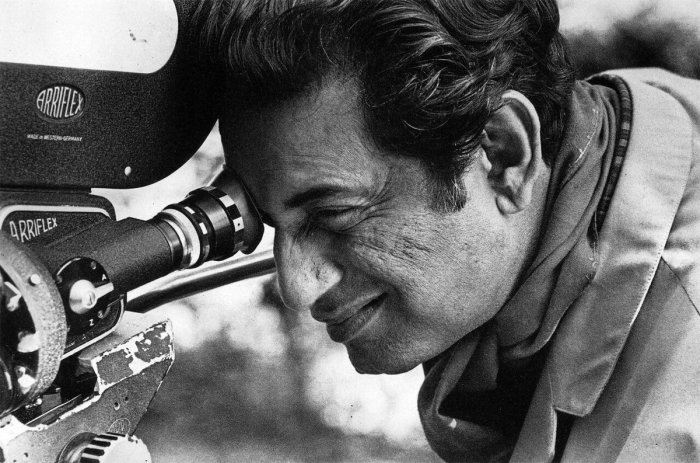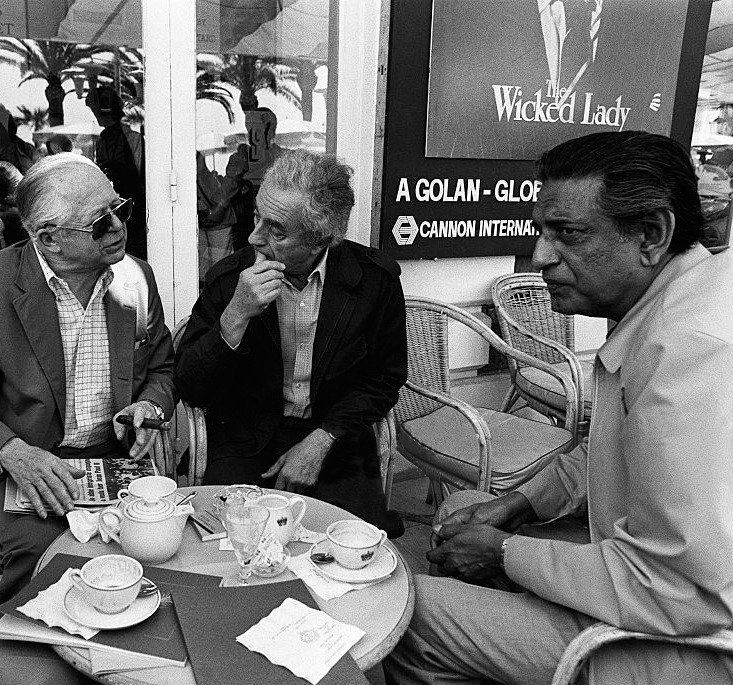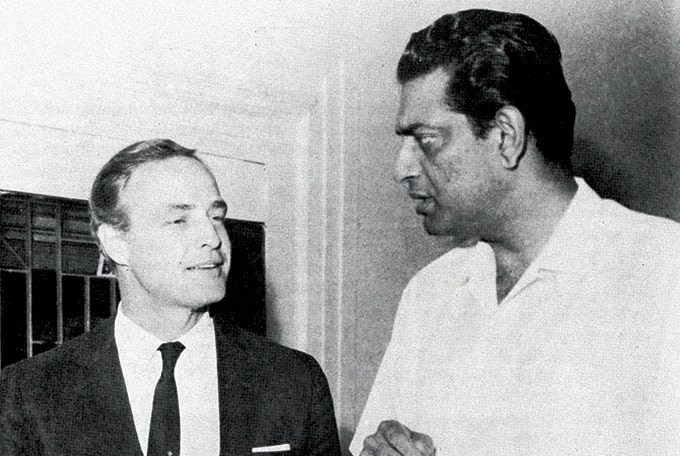Decoding Satyajit Ray through the lens of the legends

Photo: Rajiv Menon
Satyajit Ray’s body of work has fascinated legends of world cinema across generations. His mastery of storytelling left a deep mark on the creative thinking of filmmakers beyond languages, over the decades.
It is a known fact that Satyajit Ray was drawn into independent filmmaking after meeting the French filmmaker Jean Renoir and was convinced that this is what he wanted to do after he saw Vittorio De Sica’s Italian neorealist film Bicycle Thieves (1948) during a visit to London. But many all-time great filmmakers have also expressed their awe in Ray’s multi-faceted talent, perfectionism, smartness, and international method of easy storytelling.
Moving forward, he not only directed 36 films, including feature films, documentaries and shorts; but also became a bestselling fiction writer, publisher, illustrator, calligrapher, music composer, graphic designer and film critic of India. Though most of his works were produced in the Bengali language, none was restricted for the language barrier as all his books got translated and films were screened with subtitled across the world with increasing interest and sweeping popularity.
From the doyens of world cinema like Akira Kurosawa, Jean Luc Godard, Michelangelo Antonioni, Ingmar Bergman, Federico Fellini etc to the blockbuster directors of Hollywood like Francis Ford Coppola, Martin Scorsese, Richard Attenborough, Christopher Nolan and the likes, all have expressed how they were fascinated with Ray’s films and tried to think of his way of storytelling while making their own films. Ray came out as a master of masters’ who quietly shaped the thoughts of many world-class thought-leaders.

Billy Wilder, Michelangelo Antonioni and Satyajit Ray enjoying a tea break during the 1984 Cannes Film Festival (Photo Cannes Film Festival)
Not only his films, but the fictional characters created by him have become cult figures by their own merits, portrayed in films too by brilliant actors handpicked by him.
Indian cinema over many years dominated by a stereotype of Bollywood and very much localised regional ones did not have many takers in the global stage and was considered having no meat, but only song and dance. It was only Raj Kapoor’s film Mera Naam Joker (1970) that was able to make a breakthrough among the Russians.
Ray’s first film, Pather Panchali (1955), won 11 international prizes, including the inaugural Best Human Document award at the 1956 Cannes Film Festival and eventually got included in BBC’s list of 100 best foreign-language films. This was the time his work started getting noticed by the world cinema fraternity and one with regular interactions with fellow directors at various film festival circuits, he not only became a renowned name among the global directors, but legendary directors started reading his work from a different perspective.
However, the list of his films winning festival accolades is too lengthy and for many years he was the only name from India the world cinema recognised.
It is not easy to come out and declare that a great movie is inspired by another. The controversy remained hanging in the air on the similarities between Steven Speilberg’s E.T. – the Extra-Terrestrial (1982) and Ray’s script of Alien that never became a film.
Ray’s clean way of storytelling meant for everyone in the audience was different than the new wave European genre of directors, who believed in extreme subtlety and at the same time his films tasted far away from the oriental lot like the other Asian movies, for example, Akira Kurosawa, and later on Ang Lee or John Woo and even the latest ones from Bong Joon Ho if one wants to consider his works in light of today’s relevance.
But with Ray’s films, the introduction of Indian intellectual mind actually started its maiden entry into the film critique circle and slowly with one after other masterpieces doing rounds at the film festival circuits, celebrated directors started sharing how they are finding Ray’s films extremely compelling and interesting. While the respect to and from Akira Kurosawa, Ingmar Bergman was mutual, his work received some criticism from like likes of Francois Truffaut as well.

Akira Kurosawa was a close friend
Akira Kurasawa had famously said, “Not to have seen the cinema of Satyajit Ray means existing in the world without seeing the sun or the moon.” Described as full of humanism and universality, his films were considered narratives of deceptive simplicity with deep underlying complexity. Praising his contribution to the world of cinema, Hollywood director Martin Scorsese had expressed, “Ray’s magic, the simple poetry of his images and their emotional impact will always stay with me. His work is in the company of that of living contemporaries like Ingmar Bergman, Akira Kurosawa and Federico Fellini.”
Director of The Godfather, Francis Ford Coppola cited Ray to be a major influence in life. With deep words of praise for Ray’s 1960 classic Devi (1960), Coppola had said, “Whenever someone speaks from Kolkata, I remember Satyajit Ray’s call, praising me for Godfather I. He complimented me particularly for my discovery, Al Pacino, whom he considered the best actor of the 1970s. According to him, Marlon Brando was untouchable in Godfather. We know of Indian cinema through Ray’s works and, to me, his best is Devi, a cinematic milestone.”
Recently, on a visit to India, the superhero filmmaker Christopher Nolan expresses his admiration for Ray. He said, “I have had the pleasure of watching Satyajit Ray’s Pather Panchali recently, which I hadn’t seen before. I think it is one of the best films ever made. It is an extraordinary piece of work.”
Elia Kazan, the director of 1951 blockbuster A Streetcar Named Desire came to Kolkata in 1960 and spent time with Ray and became fond of him. Later Kazan had said, “In Ray, I have noticed a complete filmmaker. He has mastered the art of scriptwriting, direction, editing and scoring music — which very few in the world can equal. If he were in Hollywood, he would have proved a tough challenge for all of us. The simplicity of Pather Panchali, the poignancy of Devi, and the aesthetics of Charulata haunt me as well as many other filmmakers of the west.”

Directing Richard Attenborough
Richard Attenborough, the award-winning director of Gandhi (1982) who played the role of General James Outram in Ray’s 1977 masterpiece Shatranj Ke Khilari (The Chess Players), was mesmerised by his skilful direction.
He said, “I was honoured that one of the world’s greatest directors was eager to direct me. I submitted myself totally to him and found him to be a true actor’s director. His sense of the script and details are unparalleled.”
Hollywood director Wes Anderson dedicated his film The Darjeeling Limited (2007), to Satyajit Ray. Charu’s theme, from the film Charulata (1964), serves as an interesting leitmotif that holds the tragi-comedy of the Whitman brothers together in Anderson’s film.
“It’s one of the most unique music that we’ve ever used,” Anderson told Rolling Stone, the American magazine. “I had to personally introduce myself to the Satyajit Ray family and foundation and convince them that it was worthwhile to digitise all of his master tapes. I wound up sitting in Calcutta for five days waiting for them to hand them over. But that was one of the great experiences of my life,” he said.

Interviewing Marlon Brando for Doordarshan
The list of legendary directors, producers, actors and actresses of the world cinema who have met Satyajit Ray and were smitten by his multidimensional talents is very long. From Billy Wilder to Andrzej Wajda, James Ivory to Marlon Brando, Majid Majidi to David Lean, Gerard Depardieu to Roman Polanski, the greatest talents have acknowledged how Ray’s work quietly influenced their art and creativity and how he could have accomplished if he had gone to make films in the west. However, most of them strongly felt that his work still has not reached the global audience at large.
While nominating Ray for the honorary Oscars in 1991, George Lucas the creator of Star Wars commented, “Satyajit Ray is an extraordinary filmmaker with a long and illustrious career who has had a profound influence on filmmakers and audiences throughout the world. By honouring Satyajit Ray, the Academy will help bring his work to the attention of a larger public, particularly to young filmmakers, on whom his work will certainly have a positive effect.”
James Ivory made an even stronger comment by saying, “Satyajit Ray is among the world’s greatest directors, living or dead…Isn’t it curious that the newest, the most modern of the arts, has found one of its deepest, most fluent expressions in the work of an artist like Ray, who must make his seamless films – many have been masterpieces – in a chaotic and volatile corner of one of the world’s oldest cultures, amidst the most stringent shortages of today’s advanced movie-making material and equipment? It would be fitting to honour this great man, who has influenced so many other filmmakers in all parts of the world, and to salute him with a Lifetime Award in the spring of 1992.”

Receiving Oscars from Audrey Hepburn
But the My Fair Lady summed up the entire thing in one short sentence. Satyajit Ray was supposed to make an English film starring Shashi Kapoor, Audrey Hepburn, and Marlon Brando but to the stars’ dismay, the film never went on the studio floors. Audrey Hepburn presented the Lifetime Achievement Oscars to Ray in 1992 and said, “One of the greatest directors, at last, got his due.”









